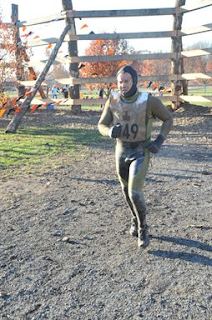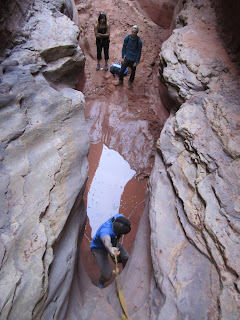How you train is going to depend on the distance you are running as well as the number and type of obstacles in the race you are running. I have run obstacle race distances of 5k (1st place), 10k (1st place), 12 mile Tough Mudder (1st place), 12 mile Spartan Beast (top 3%), and 30+ mile World's Toughest Mudder (top 20%). The training I've outlined here is not to help you finish one of these races, but to excel. With the specific every day training programs below, you will want to slowly work up to the distances and number of intervals over 2 or 3 months while following the general outline, and then work on increasing speed and reps up until the week before the event. Here is everything I know that has gotten me this far.
1. Interval running with upper body exercise in between.
One thing is universal for all obstacle racing, you need to train your body to run, complete upper body activities, and then keep running. The best way I've found to do this is by doing interval running with pull-ups, push-ups, or burpees before, between, and after intervals. If you're training in a gym, you can run intervals on a treadmill with weight lifting in between. The key with this training is to not take breaks between the running and the upper body exercises. It is miserable at first, but your body will get used to it.
2. Hills.
Running hills is also going to be extremely important. If you don't have hills to train on, then do a set of lunges or squats every half mile during your run. This will be extremely helpful whether there are hills on the course you are running or not.
3. The Long Run/ Practice Race.
Once a week, plan out and run a mock course with obstacles that will work similar muscle groups to the obstacles in the actual race. Some obstacles require you to carry something heavy, so practice that with a big rock or something for five minutes for one of your obstacles. It is also good to train wet, as you will be wet for most of the actual race. Swim across a pond, jump in a lake, or cross a river for one or more of your obstacles. Often I will plan a route that goes from park to park and I will do pull ups, cross the monkey bars, etc on the playground.
5k Obstacle Race Training (Spartan Sprint, Dirty Dash 5k, Warrior Dash, etc.):
A 5k is 3.1 miles, but when you add obstacles, you are going to want to be comfortable running 4 or 5 miles.
Monday: 6-8 x 400m intervals with upper body between each
Tuesday: 35 min run with hills
Wednesday: 2-3 x 1600m intervals with upper body between each
Thursday: 25 min run with hills
Friday: 3-5 x 800m intervals with upper body between each
Saturday: 45 min mock course with hills, obstacles
Sunday: rest
10k Obstacle Race Training (Super Spartan, Dirty Dash 10k, etc.):
A 10k is 6.2 miles, but when you add obstacles, you are going to want to be comfortable running 8 or 9 miles.
Monday: 8-10 x 400m intervals with upper body between each
Tuesday: 45 min run with hills
Wednesday: 3-5 x 1600m intervals with upper body between each
Thursday: 35 min run with hills
Friday: 4-6 x 800m intervals with upper body between each
Saturday: 60 min mock course with hills, obstacles
Sunday: rest
12 mile Obstacle Race Training (Tough Mudder, Spartan Beast):
You're going to want to be comfortable running somewhere around 15 miles.
Monday: 10-12 x 400m intervals with upper body between each
Tuesday: 60 min run with hills
Wednesday: 5-7 mile intervals with upper body between each
Thursday: 45 min run with hills
Friday: 6-8 x 800m intervals with upper body between each
Saturday: 120 min mock course with hills, obstacles
Sunday: rest
Marathon/Ultra Marathon Distance Obstacle Race Training (Spartan Ultra Beast, Spartan Death Race, World's Toughest Mudder):
Monday: 10-15 x 400m intervals with upper body between each
Tuesday: 90-120 min run with hills
Wednesday: 7-10 x mile intervals with upper body between each
Thursday: rest
Friday:10-12 x 800m intervals with upper body between each
Saturday: 30 to 50 miles mock course depending on your goal for the race
Sunday: rest
Every once in a while add in some extensive swimming, or biking. Also, try a few 300+ pull up days from when you wake up to when you go to sleep.
My Secret Key to Obstacle Race Training: Rock Climbing. Nothing will increase your grip strength and train your body to carry its own weight around like rock climbing. I climb 3-4 times a week and it helps with the obstacles more than almost anything else I do to train. Honestly the more cross training the better. If you can incorporate swimming, sprinting, biking, crossfit, or anything else active every once in a while, you will be better off.
When training for any Spartan Race, you are going to want to incorporate a lot of burpees into your training program, since they are mandatory if you cannot complete an obstacle.
One thing I've found to be important in training for the Tough Mudder is plyometrics. There are a lot of obstacles where jumping is involved, and these will be much easier if you incorporate box jumps into your training.
Specific Training for Certain Obstacles:
Army Crawl under barbed wire: For one thing, you could practice army crawling. One thing that will make it easier is planks. Working your core from this position on your forearms and toes will make army crawling that much easier.
Rope Climb: If you have a rope to climb then nothing is going to be better training than that. Otherwise, you can throw a couple of dish towels or hand towels over a pull up bar and do pull ups while gripping both ends of the towel. This will work your grip strength and pull up strength to help you train to climb a rope.
Monkey Bars: Simply go to a playground and practice. Make sure you share and take turns with the kids.
What to Wear:
Clothing: Under Armor type clothing to keep from catching on things such as barbed wire, and so it doesn't weigh you down when you get wet.
Socks: Thick running socks (I like Balega brand). If it's going to be freezing, you can try 1.5, or 2mm neoprene socks.
Shoes: Cross country flats work best in my opinion because they are extremely lightweight and drain immediately when you come out of a water obstacle (I wear an old pair of New Balances).
Gloves: I personally don't wear gloves because they get muddy, and you just don't have the same grip as your hands. A lot of people swear by them in obstacle racing. I've heard that football receiver gloves work pretty well, and also the rubber dotted gardening gloves since they drain well and are made to get muddy.
(for World's Toughest Mudder clothing suggestions, see my post from November: World's Toughest Mudder 2012)
Race Prep:
The week before the race: take a step back on your training. Cut back on distance, speed, and reps of upper body exercises. Make sure to start hydrating and carb loading early, not just the day before.
The day before the race: take the day off. Hydrate well, and eat a lot of healthy carbs.
The night before: Get plenty of sleep.
The morning of: Eat a big breakfast of healthy foods. Avoid eating too much fiber, or acidic foods like oranges or orange juice. Avoid dairy. I usually have a few pieces of peanut butter toast, a banana, and a sports drink.
The key to race preparation is implementing these same eating, sleeping, and hydration habits during all of your training. You don't want to eat things the morning of your race that you've never eaten before your training. Eat things your body is used to.























































